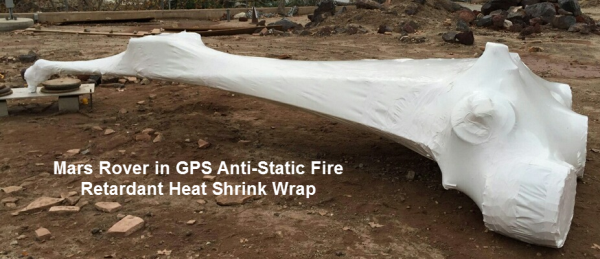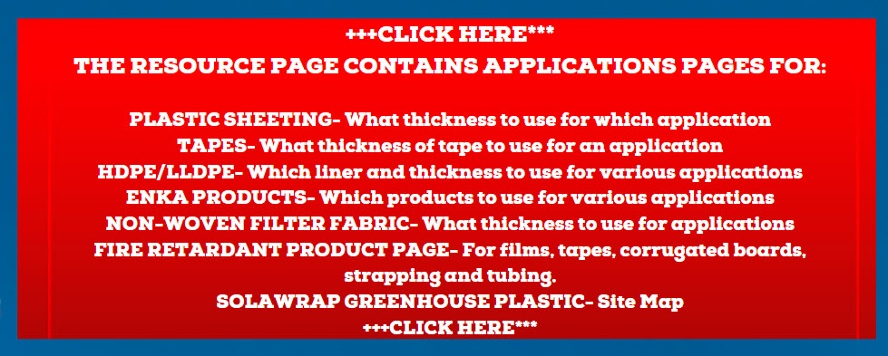OK, there are so many different types of plastic sheeting! Which plastic sheeting roll should I select? What is meant when someone mentions “flexible plastic sheeting” ? What kinds of “flexible plastic sheeting” are there? And what are the additives used to make flexible plastic films?
In its simplest terms, the main difference between the different types of plastic is the way their cellular structure, or molecules bond with each other, and how tightly they are formed. Beyond that, this incredible polymer allows us to add additives to improve the performance of the plastic.
Which is the most flexible plastic sheeting?
Linear Low Density Polyethylene (LLDPE) is the most flexible of the plastic sheeting films. LLDPE is blended form of LDPE where the film has much more flexibility, tensile strength, and more conformability. It is more pliable and softer. LLDPE is used for pond liners or blended into other films to give them more flexibility and extra strength. LLDPE is used for films that need a tremendous amount of strength to absorb impacts while not tearing or puncturing. An example of this is a carpet plastic film that adheres to the carpet. It is strong enough to withstand foot traffic, even from stiletto high heels! The molecules all line up and strongly hold together as the film is stretched. The most common thickness range is from 0.5 mil to 40 mil in flexible plastic sheeting.
Which is the most common poly sheeting?
Low Density Polyethylene (LDPE) is the most common type of plastic sheeting. It is very flexible, most often from 0.5 mil thick to about 40 mil in flexible sheeting forms. Due to its flexibility is conforms well to a variety of surfaces. Low Density Polyethylene has a .92 density. The downside is that this LDPE is not as strong or dense as some other types of plastic sheeting. It is not nearly as puncture resistant either. LDPE is used quite widely in construction, agriculture, surface protection applications, covers of all sorts, tarps and much more. It is white translucent with working temps of 0-140 deg F. and a forming temp of 245 deg F.
Which is least commonly used of them all?
Medium Density Polyethylene (MDPE) is the least commonly used form of polyethylene for flexible plastic sheeting. Its positive attributes is that it is stronger than LDPE and has a little more chemical resistant. It has a tighter cell structure making it more tear and puncture resistant. When pond liners are manufactured they are often made with MDPE and blended with LDPE or LLDPE to achieve a strong yet flexible pond liner.
Which poly film is the toughest of them all?
High Density Polyethylene (HDPE, aka HD), has the distinction of being the strongest, toughest, most chemical resistant and least flexible of the four types of flexible plastic sheeting referenced in this article. HDPE is also the most UV resistant- holding up to the harsh rays of the sun without needing UV additive packages. HDPE’s strength comes from its tight cell structure that makes it very difficult for other molecules to pass through its structure on a microscopic level. High Density Polyethylene has a density .95. When applications call for very large liners such as pond liners, HDPE is the most easily seamed or “sewn” together. Used industrially, the thickness range from 12 mils to100 mil thick. HDPE is used as secondary containment liners for oil tanks, and most industrial ponds and canal liners where chemical resistance is needed. It is white-tan, translucent with working temperatures of 32 deg F to 210 deg F and a forming temp of 310-325 deg F.
What Additives can be added to the plastic?
The image below of the Mars Rover section is using GPS Anti-Static Fire Retardant Heat Shrink Wrap. This is a good example of plastic sheeting that has a fire retardant additive as well as an Anti-static additive. The film shrinks when heat is applied to essentially seal in the contents.

Anti-static: An anti-static additive can be added to polyethylene to make it resist sparking. Anti-static films are used in the telecommunication industry as one example. Certain types of equipment can be prone to sparks which could result in a devastating fire. Anti-static fire retardant films solve this problem.
UV Stabilizers: Sunlight eats up plastic. Perhaps you have seen black plastic on piles of dirt that are flapping in the wind? That is because that torn plastic didn't have any UV stabilizers to combat the strong rays of the sun. Heavy duty plastic sheeting adds these stabilizers for films that will be used for ponds, covering anything outdoors, exposed to sun light.
Color/Pigment: It's no surprise that pigment can be added to polyethylene to make the plastic look a certain color. Just about any color can be created.
Flame/Fire Retardant: Plastic goes up in a flash if it is exposed to an open flame. Today there are fire retardant films that when exposed to a flame will not add to the fire. They will self extinguish. Note that the plastic may melt, but it won't be a fuel source to the fire.
Sip/Anti-block agents: This additive is used to improve film to film slipping.
External Coatings: Coatings can be applied to the surface of the plastic, which is designed to help wet out the surface of the film. This in turn decreases the contact angle of the water droplets and improves transparency.







